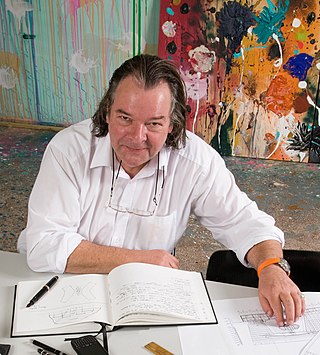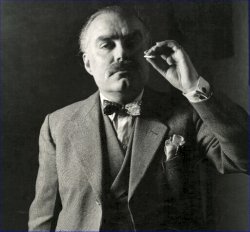
Reginald Joseph Mitchell was a British aircraft designer who worked for the Southampton aviation company Supermarine from 1916 until 1936. He is best known for designing racing seaplanes such as the Supermarine S.6B, and for leading the team that designed the Supermarine Spitfire.

Sir John Betjeman was an English poet, writer, and broadcaster. He was Poet Laureate from 1972 until his death. He was a founding member of The Victorian Society and a passionate defender of Victorian architecture, helping to save St Pancras railway station from demolition. He began his career as a journalist and ended it as one of the most popular British Poets Laureate and a much-loved figure on British television.

Charles Henry Holden was an English architect best known for designing many London Underground stations during the 1920s and 1930s, the Underground Electric Railways Company of London's headquarters at 55 Broadway, for the University of London's Senate House and for Bristol Central Library. He created many war cemeteries in Belgium and northern France for the Imperial War Graves Commission.

William Allen Alsop was a British architect and Professor of Architecture at University for the Creative Arts's Canterbury School of Architecture.

Ian Buruma is a Dutch writer and editor who lives and works in the United States. In 2017, he became editor of The New York Review of Books, but left the position in September 2018.

Sir Osbert Lancaster was an English cartoonist, architectural historian, stage designer and author. He was known for his cartoons in the British press, and for his lifelong work to inform the general public about good buildings and architectural heritage.
Ian Douglas Nairn was a British architectural critic who coined the word "Subtopia" to indicate drab suburbs that look identical through unimaginative town-planning. He published two strongly personalised critiques of London and Paris, and collaborated with Sir Nikolaus Pevsner, who considered his reports to be too subjective, but acknowledged him as the better writer.

The Tower House, 29 Melbury Road, is a late-Victorian townhouse in the Holland Park district of Kensington and Chelsea, London, built by the architect and designer William Burges as his home. Designed between 1875 and 1881, in the French Gothic Revival style, it was described by the architectural historian J. Mordaunt Crook as "the most complete example of a medieval secular interior produced by the Gothic Revival, and the last". The house is built of red brick, with Bath stone dressings and green roof slates from Cumbria, and has a distinctive cylindrical tower and conical roof. The ground floor contains a drawing room, a dining room and a library, while the first floor has two bedrooms and an armoury. Its exterior and the interior echo elements of Burges's earlier work, particularly Park House in Cardiff and Castell Coch. It was designated a Grade I listed building in 1949.
Roger Wilmut is a British writer and compiler of books on British comedy. Wilmut attended Warwick School, and began his 'day job' as studio technician for the BBC on leaving school in 1961. Wilmut claims to have drifted into a career as a writer "by accident". Wilmut's books include The Goon Show Companion, Tony Hancock: Artiste, From Fringe to Flying Circus and Didn't You Kill My Mother-in-law.

Diana Barnato Walker MBE FRAeS was a pioneering British aviator. In World War II, she became one of the first women pilots of the Air Transport Auxiliary, flying 80 types of aircraft and delivering 260 Spitfires. In 1963, she became the first British woman to break the sound barrier, flying at Mach 1.6, which also represented a world air speed record for women.
Alec Clifton-Taylor was an English architectural historian, writer and TV broadcaster.
Architecture criticism is the critique of architecture. Everyday criticism relates to published or broadcast critiques of buildings, whether completed or not, both in terms of news and other criteria. In many cases, criticism amounts to an assessment of the architect's success in meeting his or her own aims and objectives and those of others. The assessment may consider the subject from the perspective of some wider context, which may involve planning, social or aesthetic issues. It may also take a polemical position reflecting the critic's own values. At the most accessible extreme, architectural criticism is a branch of lifestyle journalism, especially in the case of high-end residential projects.
Tony Fretton is a British architect known for his residential and public gallery buildings, as well as other British and international design work. He graduated from the Architectural Association (AA) and worked for various practices including Arup, Neyland and Ungless, and Chapman Taylor, before setting up his own firm, Tony Fretton Architects, in 1982. His first major project was the Lisson Gallery in 1990. He is known for designing "location sensitive art spaces" using a combination of vernacular and minimalist approaches balancing new and age-old designs.

Owen Hatherley is a British writer and journalist based in London who writes primarily on architecture, politics and culture.

MAXXI is a national museum of contemporary art and architecture in the Flaminio neighborhood of Rome, Italy. The museum is managed by a foundation created by the Italian ministry of cultural heritage. The building was designed by Zaha Hadid, and won the Stirling Prize of the Royal Institute of British Architects in 2010.

The Supermarine Spitfire is a British single-seat fighter aircraft used by the Royal Air Force and other Allied countries before, during, and after World War II. Many variants of the Spitfire were built, from the Mk 1 to the Rolls-Royce Griffon-engined Mk 24 using several wing configurations and guns. It was the only British fighter produced continuously throughout the war. The Spitfire remains popular among enthusiasts; around 70 remain airworthy, and many more are static exhibits in aviation museums throughout the world.

Air Marshal Sir Ralph Squire Sorley, was a senior commander in the Royal Air Force (RAF). He began as a pilot in the Royal Naval Air Service during the First World War, and rose to senior command in the Second World War. After the latter he held several senior appointments until his retirement in 1948. and in 1947 was made a Commander of the Legion of Merit of the United States of America.

John Arden was an English playwright who at his death was lauded as "one of the most significant British playwrights of the late 1950s and early 60s".

The statue of John Betjeman at St Pancras railway station, London is a depiction in bronze by the sculptor Martin Jennings. The statue was designed and cast in 2007 and was unveiled on 12 November 2007 by Betjeman's daughter, Candida Lycett Green and the then Poet Laureate Andrew Motion to commemorate Betjeman and mark the opening of St Pancras International as the London terminus of the Eurostar high-speed rail link between Great Britain and mainland Europe. The location memorialises the connection between St Pancras station and Betjeman, an early and lifelong advocate of Victorian architecture.













